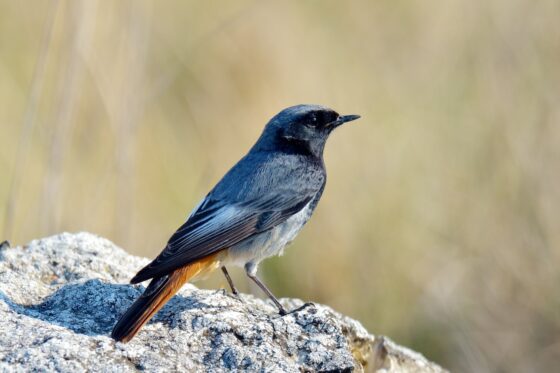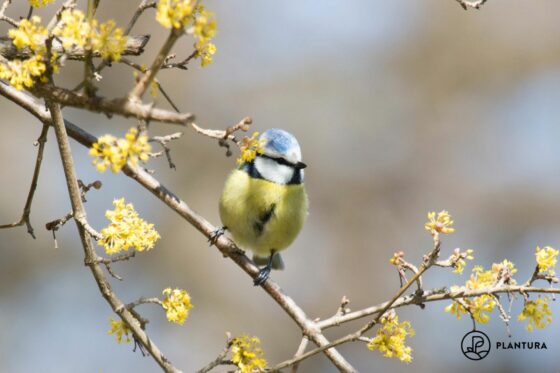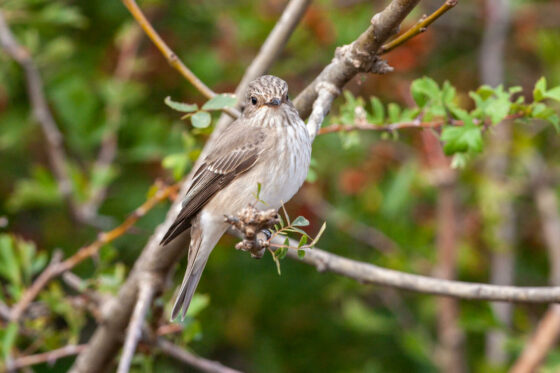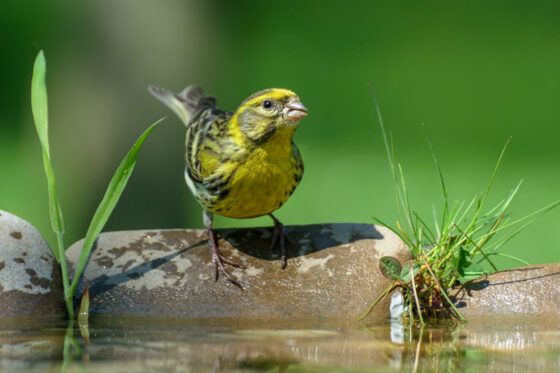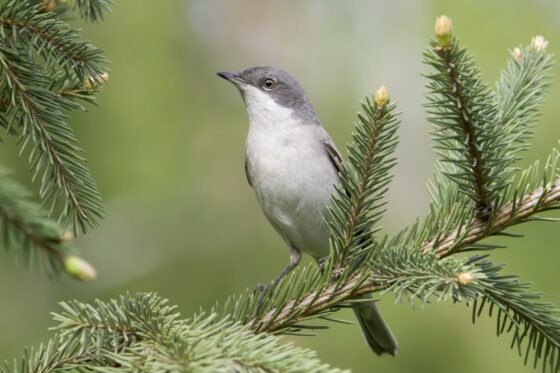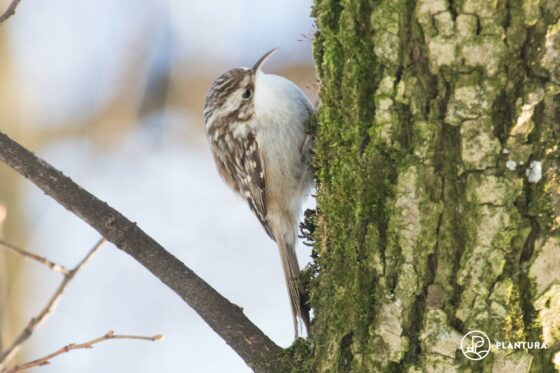Song thrush: the bird profiles
What does the song thrush look and sound like? When does the song thrush breed and what do song thrush chicks look like? Read on to find the answers to all these questions and more!
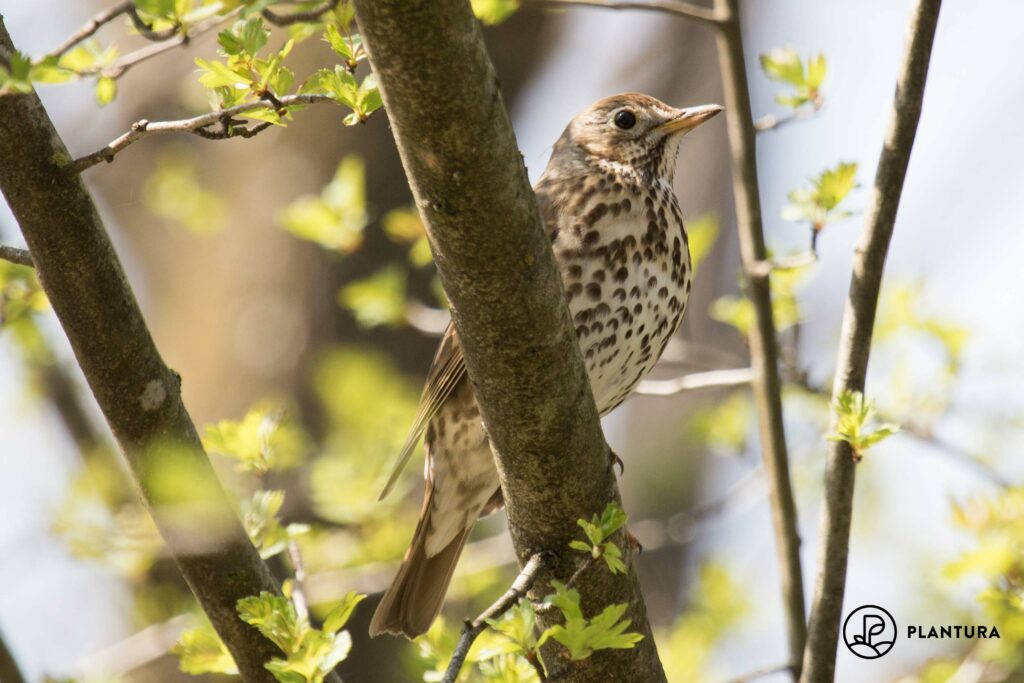
The song thrush (Turdus philomelos) is a close relative of the blackbird, which it resembles in both size and shape. In fact, you would be forgiven for mistaking a song thrush for a young blackbird. Blackbird chicks are less patterned than their parents and have a similar colour to the song thrush.
There are, however, a number of differences between the two birds. The song thrush is much brighter and more patterned than young blackbird chicks. Song thrushes also produce a melodic, creative and varied song, which they sing throughout the evening in local parks and gardens.
Read on to discover when and where the song thrush breeds, how you can support it and what that famous song sounds like.
Song thrush: key facts
| Size | about 20-22cm |
| Weight | around 60-70g |
| Breeding season | March-August |
| Lifespan | up to 10 years |
| Habitat | woodland, parks and gardens |
| Food preferences | worms, snails, insects, berries and fruit |
| Threats | loss of habitat and food sources |
How to identify the song thrush
The song thrush is slightly smaller and slimmer than the well-known blackbird. At first glance, song thrushes resemble female blackbirds and young blackbirds, sharing their brown-grey backs and wings.
The song thrush’s belly, however, is white and its breast shines with a warm yellow hue. Black, arrowhead-shaped spots form a strong pattern against this light background, and it is these spots that distinguish the song thrush from other thrush species. The mistle thrush, for example, is similar in colour but has round spots rather than arrowhead ones.

Unfortunately, it is not possible to visually distinguish male and female song thrushes. Even young song thrushes, once they have reached full size, look like their parents.
What does the song thrush song sound like?
The song thrush’s song consists of varied, multi-syllabic motifs that are typically repeated two to four times. It is quite melodic, but not as full-sounding and throaty as the song of the blackbird.
The song thrush’s call, on the other hand, consists of a pointed “zip”. When excited, this changes into a sharp “tix-tix-tix-tix”, which is similar to the blackbird’s warning call.
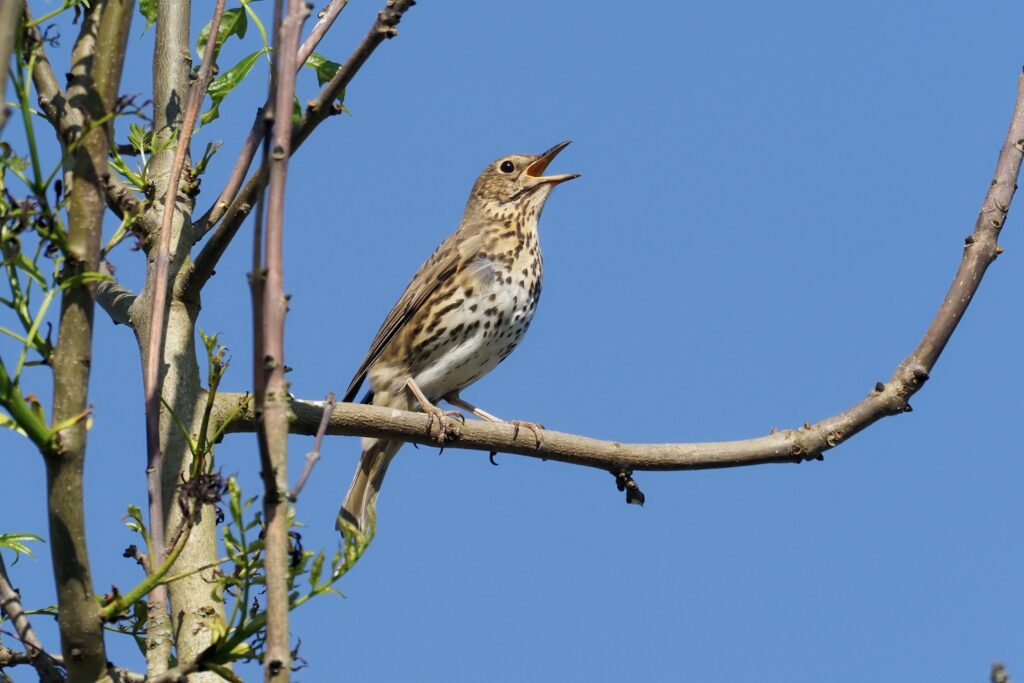
What do song thrush eggs look like?
Female song thrushes lay between four and six bright blue-green eggs, which are about 2.7 centimetres in size and covered with black spots of varying intensity.
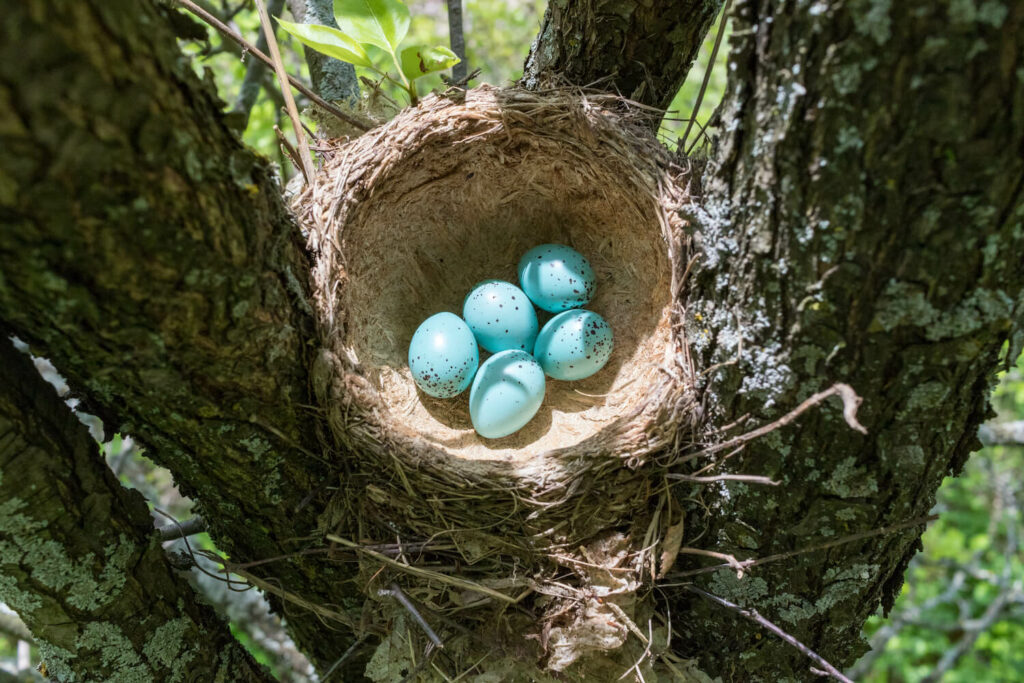
In which habitat can the song thrush be found?
Song thrushes prefer woodland that is rich in undergrowth and adjacent to open feeding grounds. However, they also feel at home in urban parks, cemeteries and natural gardens, provided there is enough protective undergrowth.
Where do song thrushes nest?
The song thrush builds its nest in the dense vegetation of trees, hedges or shrubs. However, man-made structures like wall cavities or building ledges are also used as nesting sites. The nest itself is made of small branches, moss and other plant materials, lined with a mixture of wood fibres and saliva, which forms a solid shell after drying.
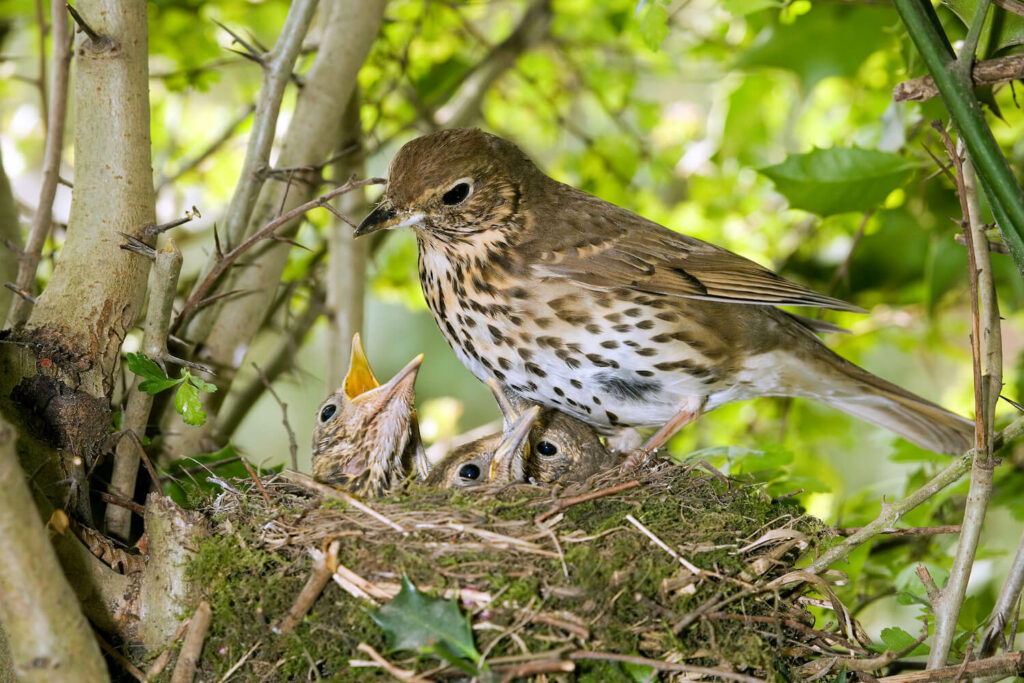
When is the song thrush breeding season?
The breeding season of the song thrush lasts from March to August. During this time, a breeding pair can successfully raise up to three broods. Each clutch remains in the nest for 12 to 14 days. Song thrush chicks are born naked and blind and are fed by their parents for two weeks before they make their first attempts to fly the nest.
Where does the song thrush spend winter?
Song thrushes are migratory birds that tend to spend winter in southern or south-western Europe. In mild winters, however, you can also see some song thrushes in Central Europe, foraging in the barren landscape. As with other bird species, wintering attempts in breeding areas may become more frequent as climate change increases.
Help the song thrush!
Due to our increasingly monocultural landscape, more and more wild birds are flocking to towns or cities, where they seek refuge in parks and gardens. Read our article on bird-friendly gardens to find out how you can create an inviting song thrush home.
What do song thrushes eat?
Most of the time, song thrushes feed on animal food such as worms, snails and insects. To get to the snail’s flesh, song thrushes have developed a clever technique: they knock the snails against a stone until the shell breaks, exposing the innards. In late spring, song thrushes also eat berries and fruits.
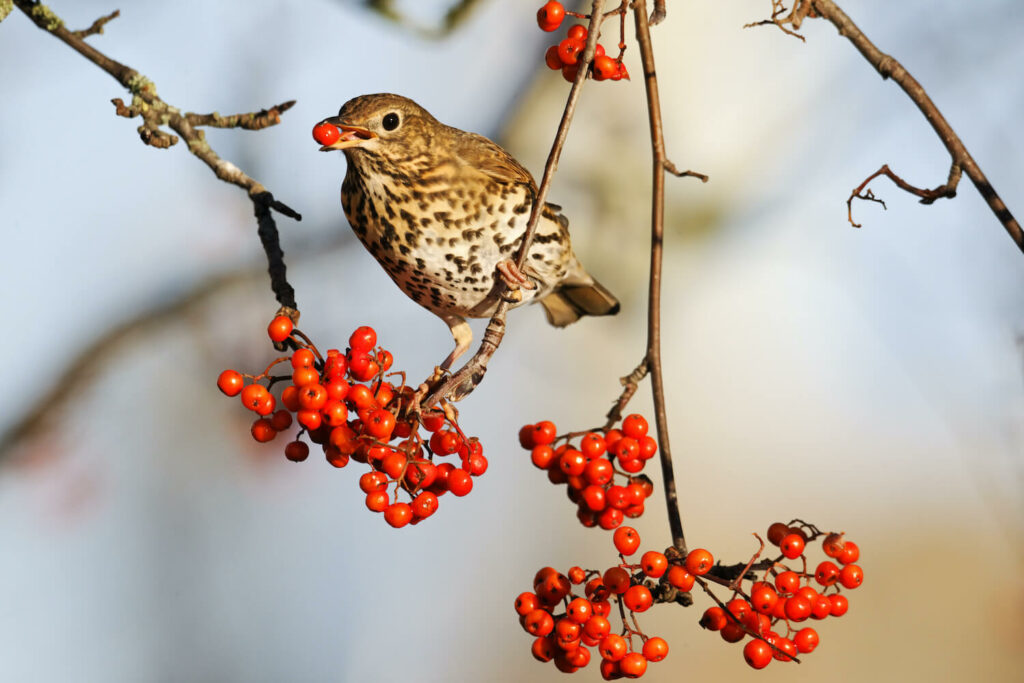
Song thrushes are not particularly interested in seeds and grains, so traditional bird food will not attract them. However, you can still support the songbirds by growing berry-bearing, bird-friendly plants, or by creating an insect-friendly garden.
Are birdhouses suitable for song thrushes?
Song thrushes build open nests, which they hide in trees and vegetation. As such, closed birdhouses are unsuitable for the song thrush. They tend to attract cavity nesting birds, such as coal tits, redstarts or nuthatches.
To support song thrushes, it is best to provide them with natural nesting sites, like hedges, shrubs and trees. Allow these plants to grow as densely as possible so that the thrushes can easily hide their nests inside the branches.
Tips for extra support
In addition to plenty of food, birds need water. In hot summers, there can often be a shortage of water in built-up areas because water sources such as puddles, ponds or streams dry up. By installing a bird bath, you can provide excellent support for the song thrush and a variety of other garden birds. Read our article on bird baths to find out what you need to consider when installing and cleaning a bird bath.
Another member of the thrush family that enjoys a plentiful garden and a bird bath is the fieldfare. Get to know this native wild bird a little better in our fieldfare profile.



















